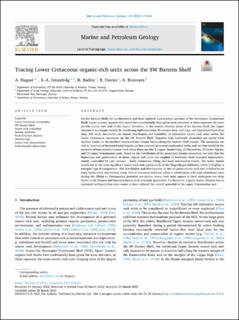| dc.contributor.author | Hagset, Andreas Hallberg | |
| dc.contributor.author | Grundvåg, Sten-Andreas | |
| dc.contributor.author | Badics, Balazs | |
| dc.contributor.author | Davies, R | |
| dc.contributor.author | Rotevatn, Atle | |
| dc.date.accessioned | 2022-04-28T11:47:41Z | |
| dc.date.available | 2022-04-28T11:47:41Z | |
| dc.date.created | 2022-04-04T13:42:11Z | |
| dc.date.issued | 2022 | |
| dc.identifier.issn | 0264-8172 | |
| dc.identifier.uri | https://hdl.handle.net/11250/2993199 | |
| dc.description.abstract | On the Barents Shelf, the northernmost and least explored hydrocarbon province of the Norwegian Continental Shelf, Upper Jurassic organic-rich shales have traditionally been given most attention as these represent the most prolific source rock unit of the region. However, in the western frontier areas of the Barents Shelf, the Upper Jurassic is too deeply buried. By combining high-resolution 2D seismic data, well logs, and digitalized Rock-Eval data, this study documents the lateral distribution and variability of alternative source rock units within the Lower Cretaceous succession on the SW Barents Shelf. Negative high-amplitude anomalies are traced from shallow basins on the platform westward into deeper basins along the western shelf margin. The anomalies are tied to intervals of increased total organic carbon contents in several exploration wells, and we thus establish the presence of four potential source rock units; these are the (1) upper Hauterivian, (2) Barremian, (3) lower Aptian, and (4) upper Cenomanian units. Based on the distribution of the associated seismic anomalies, we infer that the deposition and preservation of these organic-rich units are coupled to localized, fault bounded depocenters, mainly controlled by Late Jurassic – Early Cretaceous rifting and local reactivation events. The lower Aptian stands out as the most significant source rock unit, particularly in the Fingerdjupet Subbasin, where it displays a kerogen Type II composition. The distribution and development of this oil-prone source rock unit is linked to an early Aptian fault reactivation event. Due to increased sediment influx in combination with high subsidence rates during the Albian to Cenomanian, potential pre-Aptian source rock units appear to have undergone too deep burial in the Tromsø and Bjørnøya basins to be presently generative. Furthermore, organic matter dilution due to increased sedimentation rates seems to have reduced the overall potential of the upper Cenomanian unit | en_US |
| dc.language.iso | eng | en_US |
| dc.publisher | Elsevier | en_US |
| dc.rights | Navngivelse 4.0 Internasjonal | * |
| dc.rights.uri | http://creativecommons.org/licenses/by/4.0/deed.no | * |
| dc.title | Tracing Lower Cretaceous organic-rich units across the SW Barents Shelf | en_US |
| dc.type | Journal article | en_US |
| dc.type | Peer reviewed | en_US |
| dc.description.version | publishedVersion | en_US |
| dc.rights.holder | Copyright 2022 The Author(s) | en_US |
| dc.source.articlenumber | 105664 | en_US |
| cristin.ispublished | true | |
| cristin.fulltext | original | |
| cristin.qualitycode | 1 | |
| dc.identifier.doi | 10.1016/j.marpetgeo.2022.105664 | |
| dc.identifier.cristin | 2015162 | |
| dc.source.journal | Marine and Petroleum Geology | en_US |
| dc.relation.project | Norges forskningsråd: 228107 | en_US |
| dc.identifier.citation | Marine and Petroleum Geology. 2022, 140, 105664. | en_US |
| dc.source.volume | 140 | en_US |

